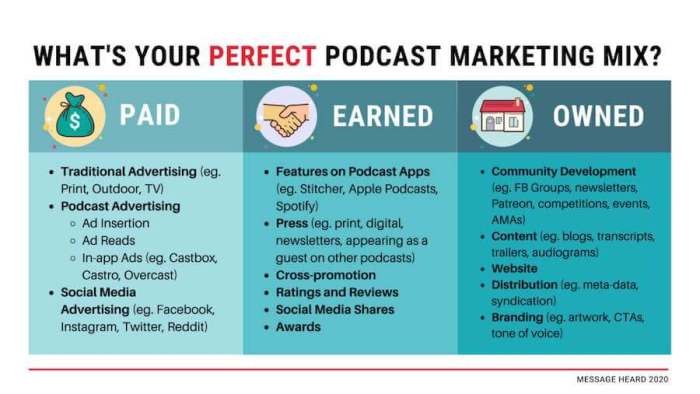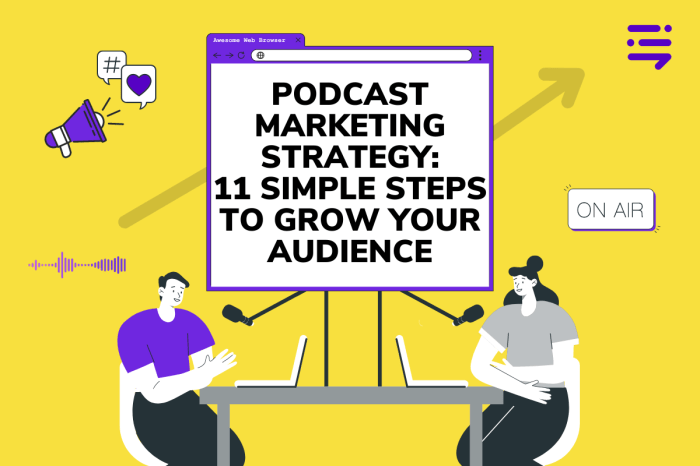Developing a Podcast Marketing Strategy sets the stage for this enthralling narrative, offering readers a glimpse into a story that is rich in detail with american high school hip style and brimming with originality from the outset.
In a world where podcasts reign supreme, understanding your audience, setting clear goals, creating killer content, and leveraging social media are key components to success. Dive into this guide to unlock the secrets of podcast marketing strategy like never before.
Understanding your target audience

Understanding your target audience is crucial for creating a successful podcast marketing strategy. By knowing who your listeners are, you can tailor your content and promotional efforts to better engage with them and attract new followers.
Researching and Identifying Your Target Audience
To research and identify your target audience, you can start by analyzing your current listenership data. Look at demographics such as age, gender, location, and interests. You can also conduct surveys or polls to gather more information about their preferences and behaviors.
- Use analytics tools to track listener data and behavior patterns.
- Engage with your audience through social media to gather feedback and insights.
- Collaborate with influencers or industry experts to reach a wider audience.
Tailoring Content and Promotional Efforts
Once you have a clear understanding of your target audience, you can tailor your podcast content and promotional efforts to better resonate with them.
- Create episodes that address topics and issues that interest your audience.
- Use language and tone that speaks directly to your target demographic.
- Promote your podcast on platforms and channels where your audience is most active.
Setting clear goals and objectives
Establishing clear goals and objectives for your podcast marketing strategy is crucial for guiding your efforts and measuring success. Without clear goals, it can be challenging to determine if your podcast is effectively reaching your target audience and driving the desired outcomes. Here are some tips on how to create SMART goals for your podcast:
Creating SMART Goals
- Specific: Clearly define what you want to achieve with your podcast marketing efforts. For example, increasing brand awareness among a specific demographic.
- Measurable: Set metrics to track the progress of your goals, such as the number of new listeners or engagement rates.
- Achievable: Ensure that your goals are realistic and attainable based on your resources and capabilities.
- Relevant: Align your goals with your overall marketing objectives and the needs of your target audience.
- Time-bound: Establish a timeline for achieving your goals to create a sense of urgency and focus.
Common podcast marketing objectives include:
- Increasing listenership: Attracting more listeners to your podcast by promoting it through various channels and engaging with your audience.
- Building brand awareness: Enhancing recognition of your brand by creating valuable content that resonates with your target audience.
- Boosting engagement: Encouraging interactions with your podcast, such as likes, comments, and shares, to foster a loyal following.
Content creation and optimization

Creating high-quality content is crucial for the success of a podcast marketing strategy. Engaging and valuable content not only attracts listeners but also helps in building a loyal audience base. It is essential to focus on creating episodes that are not only entertaining but also informative and relevant to your target audience.
Optimizing podcast titles, descriptions, and episodes
When it comes to optimizing your podcast for search engines and discoverability, it is important to pay attention to the following aspects:
- Use relevant s in your podcast titles and descriptions to improve searchability.
- Write compelling and descriptive episode titles that entice listeners to click and listen.
- Create detailed episode descriptions that provide a summary of the content and include relevant s.
- Optimize your podcast metadata, including tags and categories, to improve visibility on podcast platforms.
Best practices for creating engaging podcast episodes, Developing a Podcast Marketing Strategy
To create episodes that resonate with your target audience, consider the following best practices:
- Understand your audience’s preferences and interests to tailor your content accordingly.
- Plan your episodes in advance and create a content calendar to ensure consistency.
- Invite guest speakers or experts to add variety and depth to your episodes.
- Keep your episodes focused and organized, with a clear structure and flow.
- Encourage listener engagement through calls to action, polls, and feedback requests.
Leveraging social media and other platforms: Developing A Podcast Marketing Strategy
Social media platforms offer a powerful way to promote your podcast, increase visibility, and engage with your audience. By strategically leveraging different social media channels, you can reach a wider audience and drive more traffic to your podcast platform.
Strategies for leveraging social media
- Create engaging visuals and posts that highlight key points or interesting topics discussed in your podcast episodes. Use eye-catching graphics or quotes to grab attention.
- Share teaser clips or snippets from your podcast episodes to generate curiosity and encourage listeners to tune in for more.
- Engage with your audience by responding to comments, starting conversations, and encouraging feedback. Building a community around your podcast can lead to loyal listeners and brand advocates.
- Collaborate with influencers or other podcasters in your niche to expand your reach and tap into their existing audience.
Repurposing podcast content for other platforms
- Convert your podcast episodes into video format for platforms like YouTube to reach a different audience segment that prefers visual content.
- Transcribe your episodes into blog posts or articles to improve and reach audiences who prefer reading over listening. You can also repurpose this content for newsletters.
- Create social media graphics or quote cards using memorable quotes from your episodes to share on platforms like Instagram or Twitter.
- Host live Q&A sessions or discussions related to your podcast topics on platforms like Facebook Live or Clubhouse to engage with your audience in real-time.